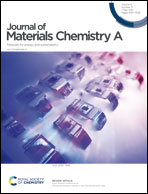Phase-transfer-assisted confined growth of mesoporous MoS2@graphene van der Waals supraparticles for unprecedented ultrahigh-rate sodium storage†
Abstract
Transition metal dichalcogenides (TMDs) are promising anode materials for sodium-ion batteries (SIBs), but suffer from low rate capability and poor cycling stability. Here, we describe our efforts in designing a unique MoS2-based van der Waals (vdW) superstructure, namely mesoporous MoS2@graphene supraparticles, for realizing unprecedented high-rate, long-life sodium storage. The key to obtaining mesoporous MoS2@graphene vdW supraparticles is the high mass loading of the initially hydrophilic (NH4)2MoS4 precursor into the hydrophobic mesoporous graphene, which is realized through a novel phase-transfer assisted method. Subsequent precursor decomposition confined in ∼11 nm mesopores triggers the epitaxial growth of MoS2 nanosheets featuring a spherically curved geometry and an expanded interlayer spacing. Thanks to the greatly improved electron and ion transport properties enabled by the unique mesoporous vdW superstructure, the resulting MoS2@graphene vdW supraparticles exhibit arguably the best rate performance ever reported.



 Please wait while we load your content...
Please wait while we load your content...